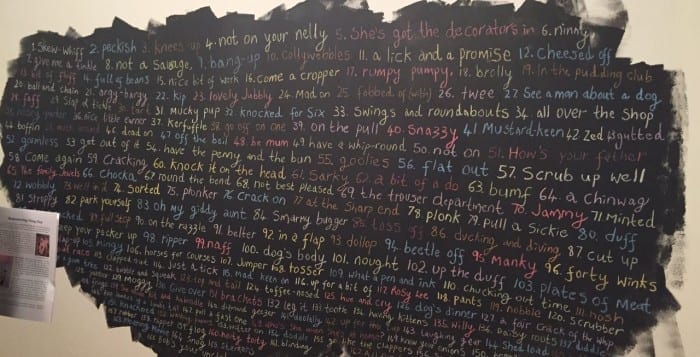Chalk another one up for local artist Annemarie Waugh
"Remembering Things Past"

When it comes to the power of Annemarie Waugh’s art, the writing is on the wall — elegantly scrawled in technicolor chalk on a black cloud of paint that remarkably, though unintentionally, resembles a map of the United States.
Her latest work, “Across the Pond,” features 166 “Britishisms” brought to life in paintings on canvas and with expressions written directly on the walls of the Islip Museum of Art.
It’s all part of the show, “Remembering Things Past,” running at the museum until the end of March.
The small room where her art is displayed is filled with wonderful British idioms, like “snog,” (to kiss), “faff,” (to waste time) and “mucky pup”, (dirty child). My personal favorite is “all fur coat and no knickers” (to have a sophisticated appearance but no substance). They’re the sort of expressions that would make you feel oh, so witty, were you to slip them into your daily conversation. Though, I’m not sure they’d sound nearly as nifty without the equally smart British accent.
Annemarie says the idea for the project began to percolate last Christmas when she was at home in England. The almost clichéd advice, “write what you know,” got her thinking.
“I know England. I know these expressions,” she says.
Inspiration to begin her text series, illustrations of some of these expressions — almost like an onomatopoeia in pencil and acrylic— soon followed. She describes the process as “thinking about the differences of the two countries and finding a visual voice that brings those memories and experiences into the work.”
Before she picked up her tools though, she started with a short story — about a paragraph long — to go with the words. Her first word was “snog.” From there, she went on to do more research in books and dictionaries, rediscovering and uncovering more expressions. She still uses some. Some, she’d forgotten. Her list has grown so much that she is actually compiling it into a book.
Annemarie told me that when she first showed the series in Patchogue last October, she didn’t want to display only paintings, so she had to figure out a way to showcase additional expressions.
“I started thinking of England and chalkboards and schools… chalkboard brings you back to remembering days long ago. It was a natural fit,” she says.
So she started practicing on the chalkboard in her son’s playroom. Though she’d used stencils for her paintings because she thought of her handwriting as “chicken scratch,” the artist says she found chalk freer and less inhibiting.
As the whole concept formed, “It was like another person stepped in and did it for me,” she says.
Installing the chalked portion of the exhibit was a project in itself. Annemarie says she was at the museum from 11 a.m. to 3 p.m. — leaving in time to get her son off the bus —for four straight days.
She painted the wall and wrote the 166 British expressions on one wall and the corresponding “American translations” on another. She very nicely numbered everything so they can easily be matched. On the fifth day, she worked with a proofreader. After all, that is a lot of writing!
 As Annemarie explains it, evenings were spent going through her lists of expressions to choose which would fit thematically and physically in her piece.
As Annemarie explains it, evenings were spent going through her lists of expressions to choose which would fit thematically and physically in her piece.
To see how she has managed to perfectly alternate each color — red, pink, blue, yellow, green, orange, purple and white— for each expression, so that the same color is never contiguous, is an impressive and powerful feat.
It’s almost like performance art, because to show the exhibit elsewhere, Annemarie would have to do it all over again!
When I asked her if the thought made her want to take a nap, she laughed. “Oh no! I’d love to do it again!” she said.
“Remembering Things Past,” can be seen at the Islip Museum of Art, 50 Irish Lane, East Islip, through March 29. Viewing is 10 a.m. to 4 p.m., Thursdays and Fridays, and noon to 4 p.m., Saturdays and Sundays. Call (631) 224-5402.






